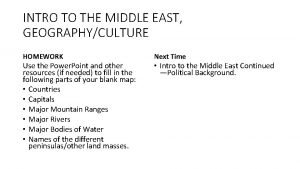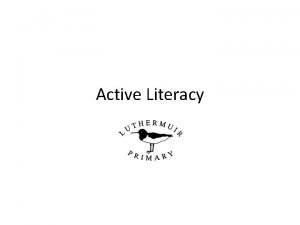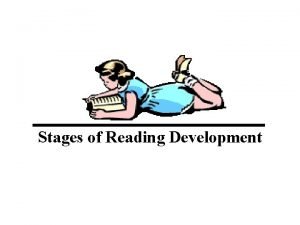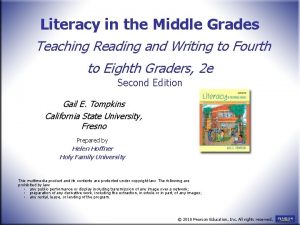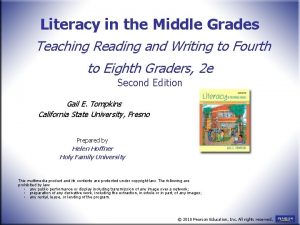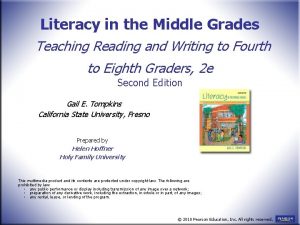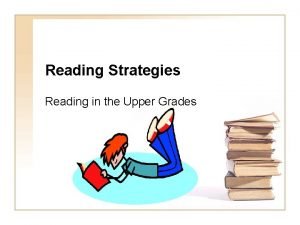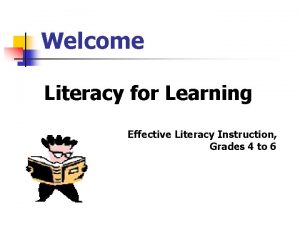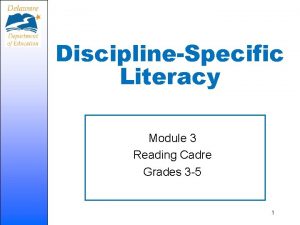Literacy in the Middle Grades Teaching Reading and












- Slides: 12

Literacy in the Middle Grades Teaching Reading and Writing to Fourth to Eighth Graders, 2 e Second Edition Gail E. Tompkins California State University, Fresno Prepared by Helen Hoffner Holy Family University This multimedia product and its contents are protected under copyright law. The following are prohibited by law: • any public performance or display including transmission of any image over a network; • preparation of any derivative work, including the extraction, in whole or in part, of any images; • any rental, lease, or lending of the program. © 2010 Pearson Education, Inc. All rights reserved.

Chapter 9 Guidelines for Teaching Writing 1. Teach students how to use the writing process 2. Teach the 6 traits and writing genres 3. Read aloud great literature to serve as mentor texts 4. Provide daily opportunities for students to read literature and explore authors and genres Literacy in the Middle Grades 2 e Gail E. Tompkins 2 © 2010 Pearson Education, Inc. All rights reserved.

Chapter 9 Guidelines for Teaching Writing 5. Have students participate in writing workshop 6. Have students self-assess their writing using rubrics 7. Have students collect their writing in portfolios Literacy in the Middle Grades 2 e Gail E. Tompkins 3 © 2010 Pearson Education, Inc. All rights reserved.

Chapter 9 Guidelines for Teaching Spelling 1. Analyze the errors in students’ writing to provide appropriate spelling instruction based on their stage of development. 2. Teach students to use spelling strategies to spell unfamiliar words. 3. Involve students in daily authentic reading and writing activities. Literacy in the Middle Grades 2 e Gail E. Tompkins 4 © 2010 Pearson Education, Inc. All rights reserved.

Chapter 9 Guidelines for Teaching Spelling 4. Involve students in making words, word sorts, and other hands-on spelling activities. 5. Teach students to proofread their writing. 6. Consider spelling tests as only one part of a spelling program. Literacy in the Middle Grades 2 e Gail E. Tompkins 5 © 2010 Pearson Education, Inc. All rights reserved.

Chapter 9 Stages of Spelling Development Stage 1: Emergent Spelling Stage 2: Letter Name- Alphabetic Spelling Stage 3: Within-Word Pattern Spelling Stage 4: Syllables & Affixes Spelling Stage 5: Derivational Relations Spelling Literacy in the Middle Grades 2 e Gail E. Tompkins 6 © 2010 Pearson Education, Inc. All rights reserved.

Chapter 9 Stages of Spelling Development Stage 1: Emergent Spelling Preschoolers and kindergartners learn these concepts: Ø The distinction between drawing & writing Ø How to make letters Ø The direction of writing on a page Ø Some letter-sound matches Literacy in the Middle Grades 2 e Gail E. Tompkins 7 © 2010 Pearson Education, Inc. All rights reserved.

Chapter 9 Stages of Spelling Development Stage 2: Letter Name-Alphabetic Spelling Spellers are typically 5 -to-7 year olds who learn these concepts: Ø The alphabetic principle Ø Consonant sounds Ø Short vowel sounds Ø Consonant blends and diagraphs Literacy in the Middle Grades 2 e Gail E. Tompkins 8 © 2010 Pearson Education, Inc. All rights reserved.

Chapter 9 Stages of Spelling Development Stage 3: Within-Word Pattern Spelling Spellers are generally 7 -to-9 year olds who learn these concepts: Ø Long-vowel spelling patterns Ø R-controlled vowels Ø More complex consonant patterns Ø Diphthongs and other less common vowel patterns Literacy in the Middle Grades 2 e Gail E. Tompkins 9 © 2010 Pearson Education, Inc. All rights reserved.

Chapter 9 Stages of Spelling Development Stage 4: Syllables and Affixes Spelling Spellers are often 9 -to-11 year olds who learn these concepts: Ø Ø Inflectional endings Rules for adding inflectional endings Syllabication Homophones Literacy in the Middle Grades 2 e Gail E. Tompkins 10 © 2010 Pearson Education, Inc. All rights reserved.

Chapter 9 Stages of Spelling Development Stage 5: Derivational Relations Spelling Spellers are generally 11– to-14 year olds who learn these concepts: Ø Ø Consonant alternations Vowel alternations Latin and Greek affixes and root words Etymologies Literacy in the Middle Grades 2 e Gail E. Tompkins 11 © 2010 Pearson Education, Inc. All rights reserved.

Chapter 9 Spelling Study Strategy 1. Look at the word and say it to yourself. 2. Say each letter in the word to yourself. 3. Close your eyes and spell the word to yourself. 4. Write the word, and check that you spelled it correctly. 5. Write the word again and check that you spelled it correctly. Literacy in the Middle Grades 2 e Gail E. Tompkins 12 © 2010 Pearson Education, Inc. All rights reserved.
 Pre reading while reading and post reading activities
Pre reading while reading and post reading activities Similarities of media literacy and technology literacy
Similarities of media literacy and technology literacy Media and information literacy venn diagram
Media and information literacy venn diagram What is a characteristic of people media?
What is a characteristic of people media? Cyber literacy for the digital age
Cyber literacy for the digital age Scaled down teaching situation
Scaled down teaching situation Literacy rates in the middle east are __________.
Literacy rates in the middle east are __________. Reading comprehension pyramid
Reading comprehension pyramid Literacy stages of reading development
Literacy stages of reading development What are the aims of teaching reading?
What are the aims of teaching reading? Type of reading
Type of reading What is extensive reading
What is extensive reading For adult
For adult






